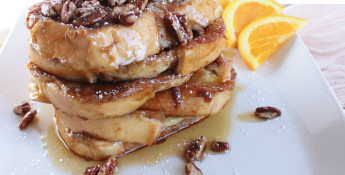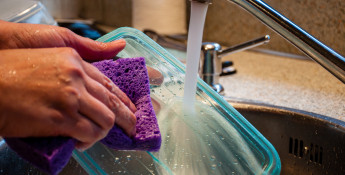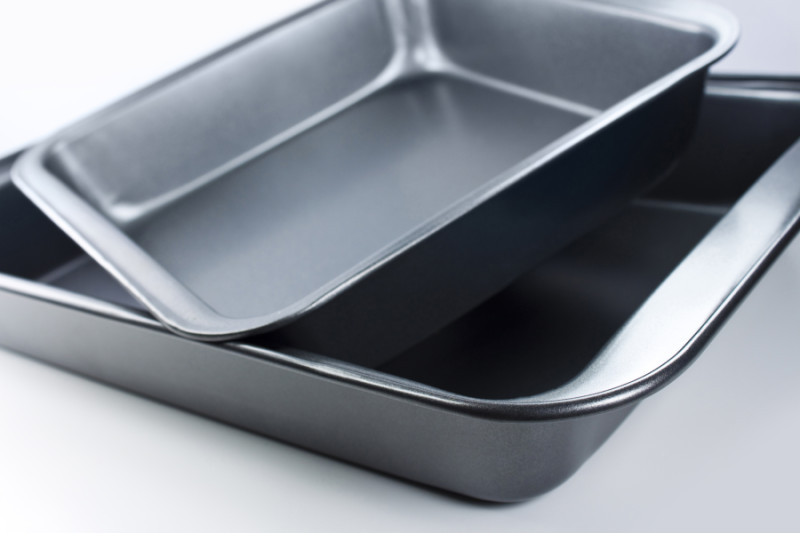By Chef Alli on September 18, 2023
Essential Baking Pans Every Cook Needs

No matter your skill level as a cook, there are a few baking pans and casserole dishes that are must haves for every kitchen.
Below is a list of basic baking pans and dishes that benefit home cooks.
The basic 9x13-inch baking pan
Of all the pans and baking dishes in our kitchen, the one most frequently used is the standard 9x13x2-inch pan.
From sheet cakes to casseroles to pasta, 9x13 pans are essential for every kitchen and I recommend you keep at least two on hand at all times.
A 9x13 pan holds 12-15 cups of food, and is available in glass, ceramic or metal.
I enjoy the 9x13 pans that come with a lid because they keep food extra fresh since they make the pans airtight.
Square baking pans: 8x8-inch or 9x9-inch
Square pans are perfect for baking brownies and bar cookies like blondies, shortbread and hello dollies.
I prefer the thicker brownies and bar cookies that a square pan can make. It is also the ultimate pan for baking cornbread. And if your family enjoys apple crisp or peach crumble, a square pan is perfect.
Commercial-quality half sheet pans: 18x13-inch with 1-inch sides
Half sheet pans are a home cook’s “go-to” for baking cookies, sheet cakes and pastries. All that surface area makes them great for roasting vegetables and making quick sheet pan dinners.
Over the years, I’ve learned that baking sheets are not the place to cut corners. Heavy-duty stainless steel or aluminum baking sheets with rimmed sides are essential. The rim around the edge keeps ingredients contained during the transfer from the counter to oven. It is also helpful when tossing roasted vegetables and other ingredients as a part of the cooking process.
Heavy-duty sheet pans don’t warp and distribute oven heat evenly, enabling foods to cook more quickly. Thin bottomed sheet pans heat up too quickly, often causing baked goods to burn on the bottom.
Round cake pans: 9-inch or 10-inch
This is a standard pan size for traditional layer cakes, but if you prefer the layers to be thicker, 8-inch cake pans are available.
Cake pans are also perfect for baking biscuits, sweet rolls, brownies, bar cookies and even quiche.
Purchase cake pans that are at least 2-inches deep and have heavy-duty construction to conduct heat well; this ensures your layer cakes can rise evenly as they bake.
Pie pans: 9-inch or 10-inch
I prefer ceramic pie pans instead of metal. Metal pie pans heat up much quicker than ceramic or glass. Once a ceramic pie pan is hot, it stays hot longer than metal, promoting lots of flaky and golden brown pastry crust.
I also prefer pie pans that come with a flat rim. The exterior lip around the edge makes fluting the pie crust with your fingertips much easier. The flat rim also provides a place for the crust to lay as it bakes, helping keep the top edge of the pie crust from sliding down the sides of the pie pan.
Pie pans aren’t just for pies, especially if you’re using deep-dish pie plates (1.5-inches to 2-inches deep) that accommodate a lot of filling. They are great for making quiche, small batch cinnamon rolls and cheesecakes.
Muffin pans: Nonstick stainless steel and silicone
If your family enjoys cupcakes and muffins, a couple of good muffin pans are essential and will hold up batch after batch. I like to have a non-stick stainless-steel muffin pan as well as a silicone muffin pan.
Even though the stainless-steel pan conducts heat slower than an aluminum muffin pan (making your baked goods take longer to bake), your muffins have more lift and a nice round dome on top.
My favorite perk of the silicone pans is how easily they release baked goods when it’s time to remove them, and no greasing is required.
The silicone makes clean up a breeze and since it’s flexible enough to collapse, minimal storage space is needed in the cupboard.
Loaf pans: 8.5x4-inch or 9×5-inch
Bread pans are typically 2.5-inches tall. The two most popular bread pan sizes are 9×5-inches (holds 8 cups of batter) and 8½x4-inches (holds 6 cups of batter).
While the difference in size may seem small, it can affect the outcome of what you’re baking, especially quick breads, such as pumpkin or banana bread. If your recipe calls for an 8½x4-inch pan and you use a 9×5-inch, your bread could fall flat instead of properly rising.
On the other hand, if your recipe calls for a 9×5-inch pan and you use an 8½x4-inch pan, your batter may overflow and burn in the oven.
For the best golden-brown baking experiences, look for heavy-duty loaf pans made from stainless steel, aluminum, ceramic, cast iron or stoneware.





